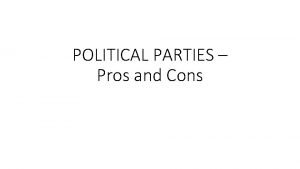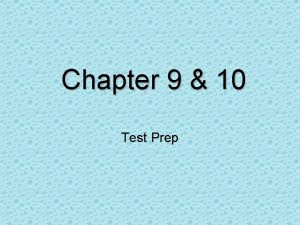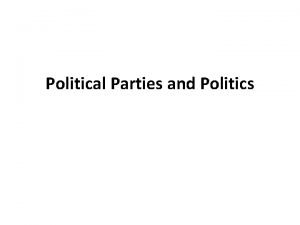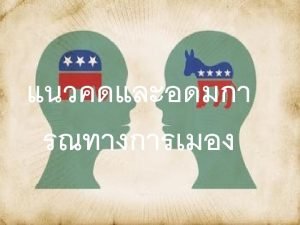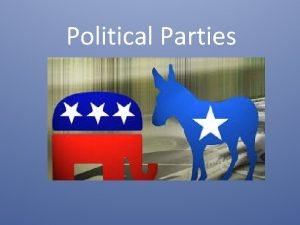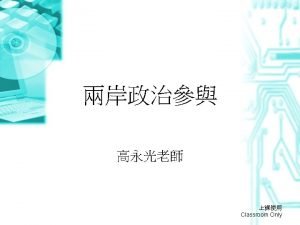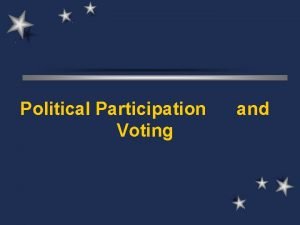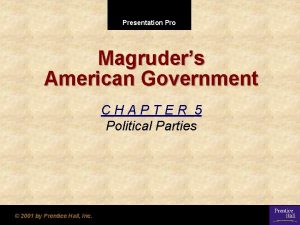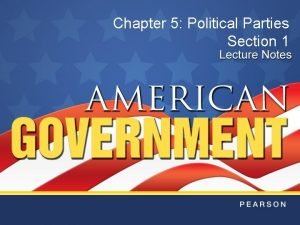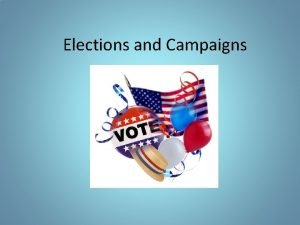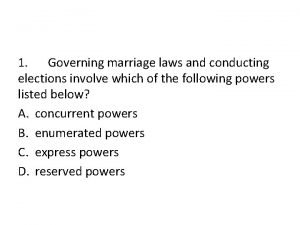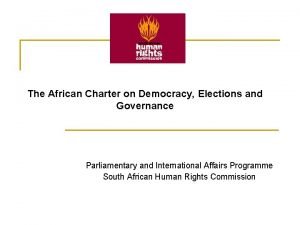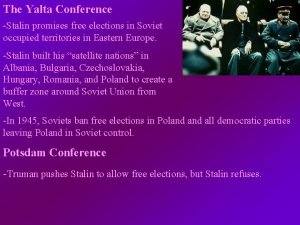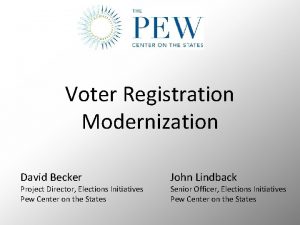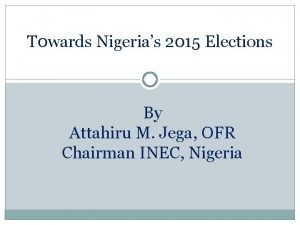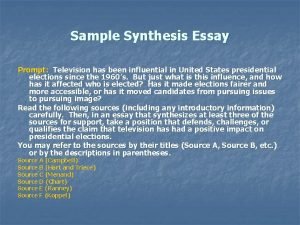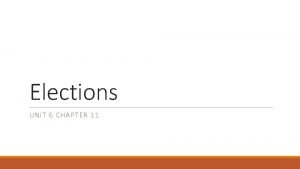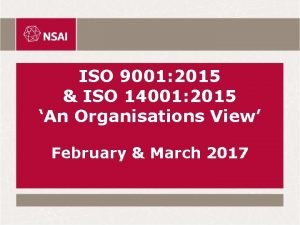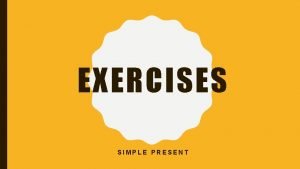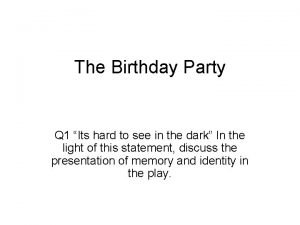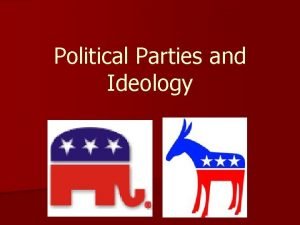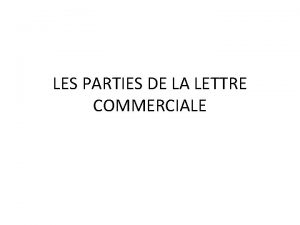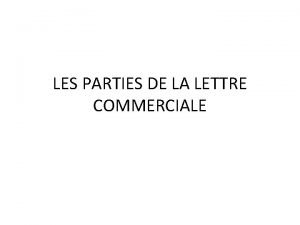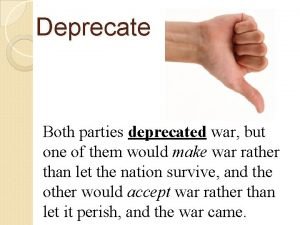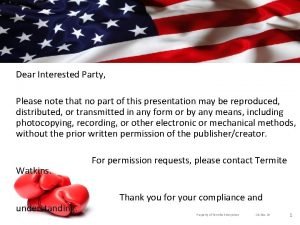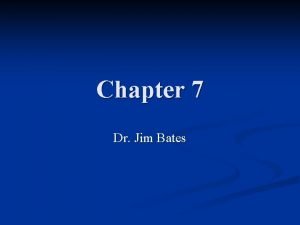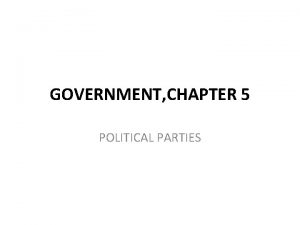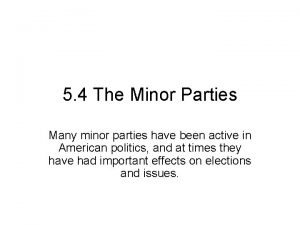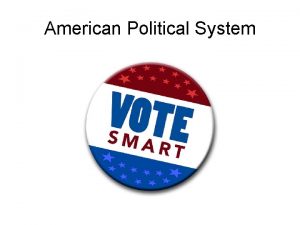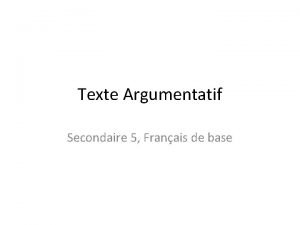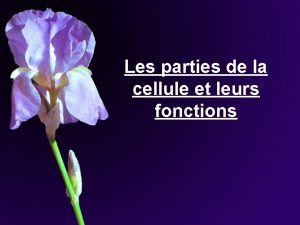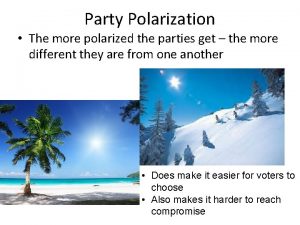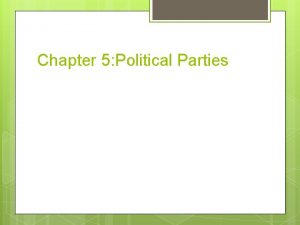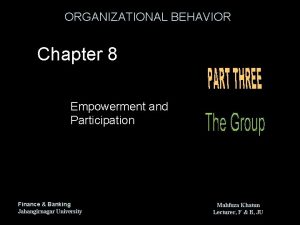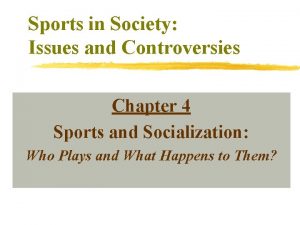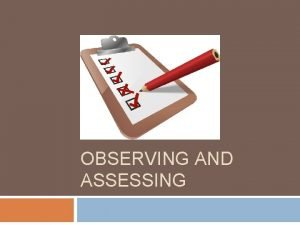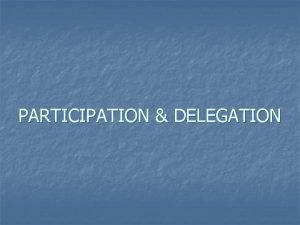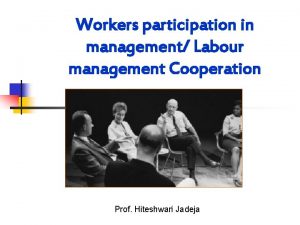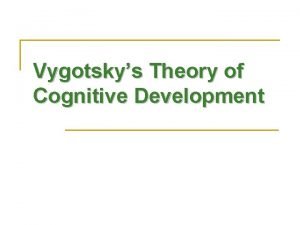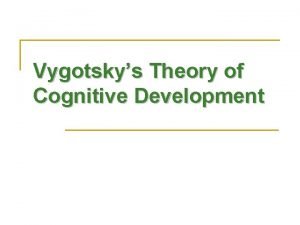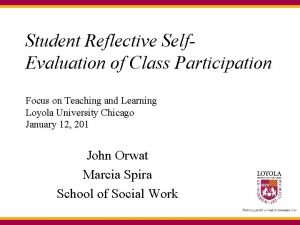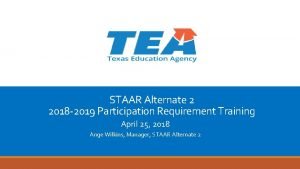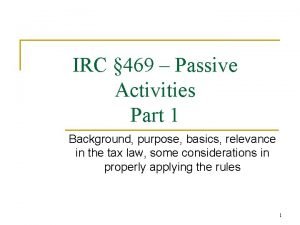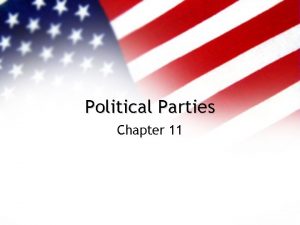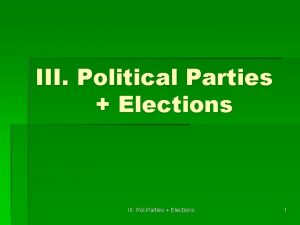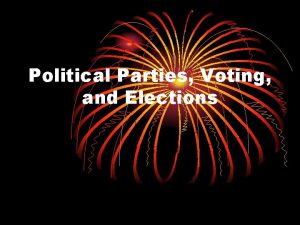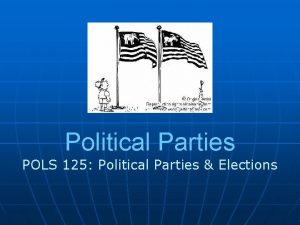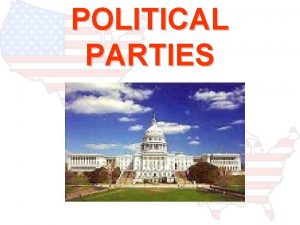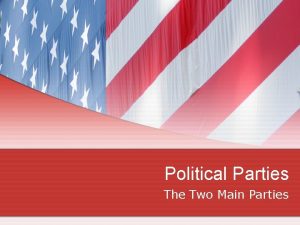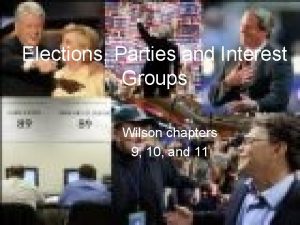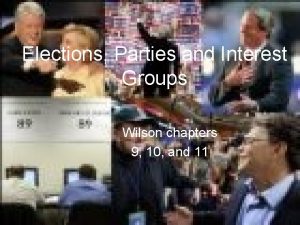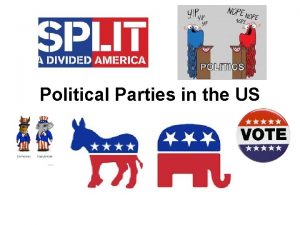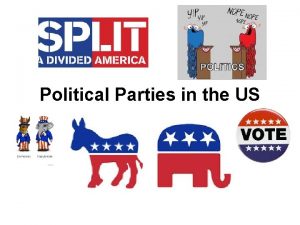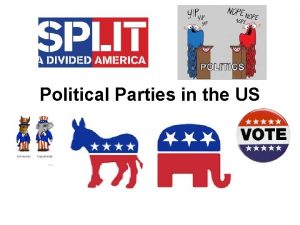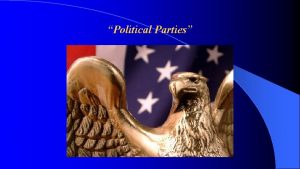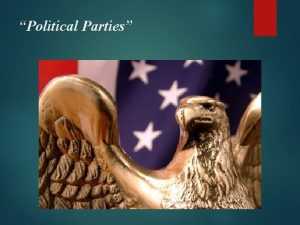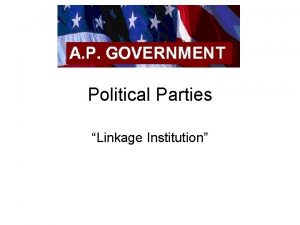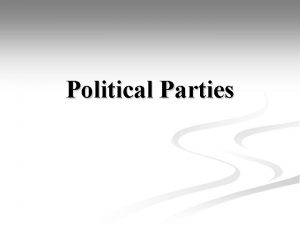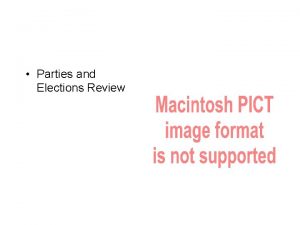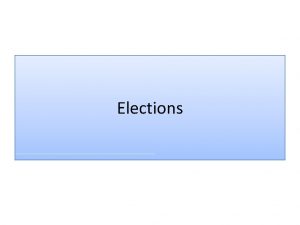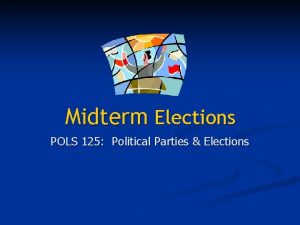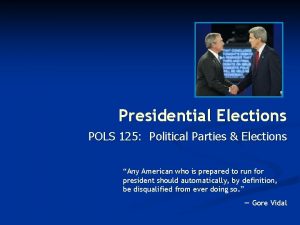Chapter 7 Political Parties Participation and Elections Political
































































- Slides: 64

Chapter 7 Political Parties, Participation, and Elections

Political Parties, Participation, and Elections

What Are Political Parties? • Political parties: organized groups that attempt to influence the government by electing their members to local, state, and national offices. • Important link between public and government Voters – Parties Elected Officials Especially true in elections, parties filter participation

What Are Political Parties?

What Are Political Parties? • Utility in American government and politics – – Increase political participation Provide important information cues to voters Promote party’s causes and issues Organize congressional business

Parties and Elections • Recruiting candidates – A quality candidate needs: • Good name recognition • Previous experience in office • Ability to raise large amounts of money • Understanding of the key issues • Ability to withstand severe scrutiny

Parties and Elections • Mobilization: getting out the vote – – – Get supporters registered Keeping online groups engaged Turning out their base on election day Operate phone banks, put up yard signs Offer rides to polling stations Parties subsidize the costs of informing and mobilizing voters

Parties and Elections • Facilitating voter choice – Americans vote on many more officials than most citizens of other countries do. – This requires Americans to be informed about more candidates. – Parties make obtaining this information easier. – People use party as an information “shortcut” when making voting decisions.

Parties and Government • Parties in Congress – Both chambers organize functions through committees that are divided by party. – The majority party has the leadership roles. • President and party – If Congress is controlled by the opposition party, then we often see gridlock and delay rather than cooperation (divided government). – President is de facto head of his party.

Parties Organize Power in Congress

What Are Political Parties? • American two-party system – Winner takes all single-member districts. • If candidate wins by 20%, or. 001%, same result – Losing party gets no representation from that specific district. • Unlike proportional pepresentation systems – Multi-member districts/states, party wins number of seats in proportion to the share of votes won in election • Third parties less viable; voters feel “wasted vote” – No incentive to vote for candidates who cannot win because that point of view will not get represented.

Electoral Alignments and Realignments • Realignments – Occur when issues that currently separate the two parties decline in relevance – New issues emerge that parties center around. – Dramatic shifts in which party governs – Dramatic shifts on positions the parties support • Example: Republicans and Democrats on civil rights

Party Systems

Party Systems • The first party system: Federalists and Jeffersonian Republicans – Federalists: stronger federal government, assumption of Revolutionary War debt, protective tariffs, commercial ties with Britain – Jeffersonians: free trade, agriculture, relations with France

Party Systems • The second party system: Democrats and Whigs – Intense competition for votes led politicians to increase suffrage. – Parties divided more by personalities and petty politics than by significant ideologies – Eventually, the Whigs were replaced by a coalition of free labor, free soil, and free land supporters.

Party Systems • The Civil War and postwar system: Republicans and Democrats – Republicans: higher tariffs to protect industry, no slavery in new territories, westward expansion – Democrats: lower tariffs to promote agriculture, smaller, local government, pro-slavery

The Civil War and Post-Civil War Party System

Party Systems • The System of 1896: Republicans and Democrats – America became far more urban and industrialized at the end of the nineteenth century. – The Populists and then the Democrats appealed to workers’ and farmers’ interests.

Party Systems • The New Deal party system – – – Franklin Delano Roosevelt elected in 1932 Expanded reach of government Began regulating the workplace Created a social safety net Created a broad coalition of voters that sustained it until the late 1960 s

Party Systems • The contemporary American party system – GOP broadens base of economic and social conservatives, especially Southerners – Ideological divide increases among elected officials, within ranks as well • Tea Party (not an actual political party) illustrates base frustration with GOP elected officials • Progressive activists, Occupy Wall Street most notably, illustrate base frustration with Democratic party.

Electoral Alignments and Realignments • Third parties – Represent social and economic interests not voiced by the two major parties – Potential influence in pushing two parties to address their issue(s) if they are taken seriously by voters and media – Significant structural obstacles make it hard for third (or more) parties to get on the ballot.

Parties and Candidates in 2012

Parties and the Electorate Party Identification 1952– 2010

Party Identification by Social Groups, 2008

How Do Voters Decide?

How Voters Decide • Three factors – Partisanship • People with strong party identification vote at higher rates, even if the contest is not competitive. – Issues and policy preferences – Candidate characteristics

How Do Voters Decide? • Issues and policy preferences – Candidates take strong stands on issues to differentiate themselves from other members of their party or past leaders. – Difficult to vote based on issues when candidates only address “safe” topics or seem to differ little on important issues

How Do Voters Decide? • Candidate characteristics – – – Religion Race and ethnicity Gender Social background Perceived personality traits Career

Candidate Characteristics Are More Important in the Media Age

Why Do People Vote?

Voting • Suffrage extended to different groups at different points in American history. Initially only wealthy, white, male, >21 yrs – Wealth limitation eliminated early 1800 s – Fifteenth Amendment enfranchises black men (1870) – Nineteenth Amend. enfranchises women (1920) – Twenty-Fourth Amend. ends poll taxes (1964) – Twenty-Sixth Amend. lowers age to 18 (1971)

Voting • Right to vote: all American citizens >18 yrs. old – 10 states (as of 2012) lifetime ban convicted felons • Turnout relatively low today – Other democracies and points in American history – 60 percent national average presidential elections – 33 percent national average in off-year national races • Significant state and regional differences

Voting

Voting Voter turnout in democratic nations 1945– 2008

Voting • Why Do People Vote? 1. Individual preferences and traits – Partisanship, ideology, religion, sex, income, etc. 2. Political environment – Campaigns, issues, mobilization, party competition 3. State policies – Registration deadlines and methods, identification, ballot types (paper, mail only, etc. )

Voting • Political mobilization – Process by which large numbers of people are organized for a political activity – Online and/or in-person mobilization activities include ads, calls, emails, campaign events, fund-raising, and others. • Not all people are mobilized equally. – Turnout disparities reflect mobilization differences. – Other factors, but mobilization an important one

Online Political Participation Is Surging

Voting • Individual traits and preferences – Demographic indicators • Education, income, sex, race/ethnicity, age • Education: highest impact because influences so many other factors correlated with voter turnout information, efficacy, and of course, income • Preferences and attitudes –Party attachment, ideology, issue positions • Makes sense: people with well-formed opinions vote.

Voting • Political environment – Context can attract voters to the polls – Candidates, pressing issues – Mobilization strategies and investment – Party competition (or lack thereof) • Consistently competitive or noncompetitive • Voters, candidates, parties, and contributors ALL take party competition into account.

Voting • State policies – All states implement voting and election laws differently. Some make it easier than others. • • • Registration deadlines prior to election day Length of residency at current address Identification requirements Early and absentee voting rules Variable vote locations Ballot method: mail only, paper ballot, kiosk, etc.

Types of Elections • Four types of elections: – – Primary General Runoff Referendum elections • Proposed laws placed on the ballot for statewide vote

Types of Elections • Primaries – Parties choose candidates who will run in the general elections. • Primaries do not elect people to office. – Open v. closed primaries • Voters can participate in either party primary, or not. • Voters do or do not register with party affiliations. • States may have caucuses; members meet and vote in the open.

Types of Elections • General elections – Determine who gets to hold office – Typically draws the most voters • Runoff elections – If a candidate does not win a majority in the general election, some states hold a runoff between the two highest vote-getters.

Types of Elections • Direct democracy – Legislative referenda: all 50 states’ legislatures refer policy to the public for a popular vote – Popular referenda and initiative: 24 states, citizens petition to place issue on ballot for a vote • Bypass the legislature • Often controversial and/or expensive policies – Recall elections: 18 states, citizens vote to remove elected official from office

Electoral College • Founders created electoral college because citizens were not trusted to make good decisions. – Even today, citizens do not directly vote for president, but rather for electors. • State electoral votes = number of U. S. Representatives + Senators (2) • All states but Maine and Nebraska allocate all electoral votes to the popular vote winner.

The Electoral College Still Organizes Presidential Elections

The 2008 and 2010 Elections • 2008 election – First African American candidate – Prominent female candidates – Many traditionally Republican states had a majority of Democratic votes

Distribution of Electoral Votes in the 2012 Election

Campaign Finance • Sources: – – Individual donors Political Action Committees (PACs) The candidates themselves Independent spending committees— 527 and 501(c)(4)

Party Organization • Hard money, soft money, and 527 s – Hard money was used for campaigning; soft money for party building. – 2002 Bipartisan Campaign Reform Act outlawed soft money – 527 s: nonprofits that can campaign for, but not coordinate with, the candidates – Citizens United allows unlimited, anonymous donations via interest groups; significant impact

Campaign Finance • Individual donors – Can donate limited amounts to individual candidates, parties, PACs, and independent spending committees – Can also “bundle” contributions to increase donations • The candidates themselves – Extremely wealthy candidates have an advantage – Examples: Mitt Romney, Michael Bloomberg

Campaign Finance • Political Action Committees (PACs) – Organizations established by corporations, labor unions, or interest groups to channel their member’s contributions into political campaigns • There are over 4, 500 PACs, and each can donate up to $5, 000 to each individual candidate.

Campaign Finance • Independent spending committees: 527 and 501(c)(4) – Groups not covered by the Bipartisan Campaign Reform Act of 2002 – 527: A political advocacy group – 501(c)(4): A nonprofit group that is also involved in politics – Allow donors to give much more than the limits imposed on individuals and PACs

Campaign Finance • Public funding – Candidates who take public funding must adhere to campaign spending limits. – Those who turn down public funding have no limits on what they can spend.

Public Opinion Poll Should there be limits on the amount of money candidates can spend on campaigns? a) Yes b) No

Public Opinion Poll Several countries (that are democracies) have compulsory voting policies that require all citizens to vote and fine those who do not. Should the United States adopt such a policy to increase voter participation in American elections? a) Yes b) No

Public Opinion Poll Do you think more people would vote if there were more convenient options, like weekend or online (secured website) voting? a) Yes b) No

Public Opinion Poll Do you think more people would vote if there were more viable political parties (maybe three to five) instead of only two as we have now? a) Yes, more people would vote. b) No, more parties would have no impact on turnout. c) Fewer people would vote; it would cause confusion.

Public Opinion Poll State rules governing the voting process— deadlines, early/absentee options, ballot method— vary widely. Should all states have the same rules on these aspects to voting and elections? a) Yes b) No

Chapter 7: Political Parties and Elections • Quizzes • Flashcards • Outlines • Exercises wwnorton. com/we-the-people

Following this slide, you will find additional images, figures, and tables from the textbook.

How the Party System Evolved

The 2012 Presidential Election Season

Campaign Funds
 Simbol lrs
Simbol lrs Political parties pros and cons
Political parties pros and cons Win the white house brainpop
Win the white house brainpop The spoils system made political parties more powerful by
The spoils system made political parties more powerful by Political parties
Political parties Political parties
Political parties Political parties
Political parties Sistemas democraticos
Sistemas democraticos Political parties
Political parties Milbrath
Milbrath Gladiatorial political participation
Gladiatorial political participation Chapter 5 section 1 parties and what they do
Chapter 5 section 1 parties and what they do Chapter 5 section 1 parties and what they do
Chapter 5 section 1 parties and what they do Presidential elections exploration and announcement
Presidential elections exploration and announcement Governing marriage laws and conducting elections involve
Governing marriage laws and conducting elections involve African charter on democracy, elections and governance
African charter on democracy, elections and governance Chapter 5 section 4 the minor parties reviewing key terms
Chapter 5 section 4 the minor parties reviewing key terms Stalin promise free elections
Stalin promise free elections David becker elections
David becker elections Conclusion on elections
Conclusion on elections Ap lang synthesis essay television presidential elections
Ap lang synthesis essay television presidential elections “elections are key to democracy”
“elections are key to democracy” Accounting information system chapter 1
Accounting information system chapter 1 Chapter 7 citizen participation in a democracy answers
Chapter 7 citizen participation in a democracy answers Iso 14001 risk and opportunities examples
Iso 14001 risk and opportunities examples Sarah and pam often go to parties
Sarah and pam often go to parties A birthday party essay
A birthday party essay Define ideological parties
Define ideological parties Foods party
Foods party Les parties de la lettre commerciale
Les parties de la lettre commerciale Parties de la lettre
Parties de la lettre Corps du dauphin
Corps du dauphin Deprecate in a sentence
Deprecate in a sentence Dear interested parties
Dear interested parties Diaphragme microscope
Diaphragme microscope Why does george wilson lock myrtle in the bedroom
Why does george wilson lock myrtle in the bedroom Economic protest parties definition
Economic protest parties definition Plan de texte narratif
Plan de texte narratif Four types of minor parties
Four types of minor parties Socialist parties
Socialist parties Le texte informatif alloprof
Le texte informatif alloprof Membrana tympani
Membrana tympani Parties de la cellule
Parties de la cellule The great gatsby jeopardy
The great gatsby jeopardy Power point parties
Power point parties Barbara hinchcliffe
Barbara hinchcliffe Innovator role of minor parties
Innovator role of minor parties Gaines techniques parties communes
Gaines techniques parties communes Splinter parties definition
Splinter parties definition Empowerment and participation in organizational behavior
Empowerment and participation in organizational behavior Pleasure and participation sports
Pleasure and participation sports Participation chart advantages and disadvantages
Participation chart advantages and disadvantages Spreading excellence and widening participation
Spreading excellence and widening participation Thank u for attention
Thank u for attention Thank you very much for your attention.
Thank you very much for your attention. Participation continuum
Participation continuum Forward and backward participation in gvc
Forward and backward participation in gvc Widening participation and spreading excellence
Widening participation and spreading excellence Financial literacy and stock market participation
Financial literacy and stock market participation Workers participation in management
Workers participation in management Vygotsky theory
Vygotsky theory Vygotsky guided participation example
Vygotsky guided participation example Class participation self-evaluation essay
Class participation self-evaluation essay Staar alt 2 justification examples
Staar alt 2 justification examples Section 469 material participation
Section 469 material participation

